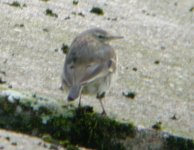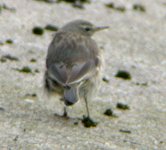Binocularface
You've all got one...............!
Hi JaneJane Turner said:Tris - don't think I am having ago.. 25 years a go I thought I could do these things 9/10 times... and then I saw a lot of water pipits.... then I started getting doubts and see very few def Water pipits now.. and a lot more Rockits!
No problems, did not take it that you were having a go!
This thread has been fascinating and eduacational, which is why I have kept plugging at various comments for more detail.
I have spent another 3 hours today watching the Campfield Pipits at relatively close range. One of the birds has almost made the transition into breeding plumage, and (IMHO) there cannot be any question that it clearly is a Water Pipit (on the proviso that current understanding of ID criteria for this species can be trusted). The second bird is far less advanced, however I watched it preening several times and was able to see the bright white wedge on the 5th outermost TF!
I attempted to photograph the birds today, though doubt if the quality will be good due to light/distance etc, however if any of them are any use I will post them later.
Regards
Tristan





